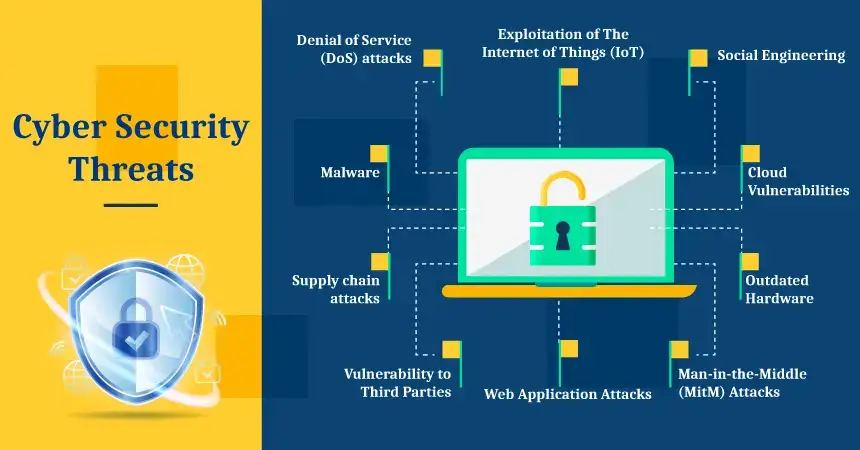The internet and other digital devices are making life much more comfortable. However, everything has a negative side, and the modern digital world is no different. Thus, technological innovation has also given a way to cyber security threats for attackers. The internet has improved our lives today, but it also has several issues regarding security. Furthermore, security risks are probably going to get more expensive as they get advanced. In this blog, we will talk about top cyber security risks or threats and how to avoid them.
List of Top 10 Cyber Security Threats
Below are the top cybersecurity risks that you must watch out for and avoid becoming a victim.

-
Exploitation of The Internet of Things (IoT)
Millions of devices from all over the world link to the internet using IoT. Therefore, there is a network of interconnected devices that can store, send, and receive data. Because of its convenience, many users and organizations depend on IoT. But, what is easy for you, is also simple for online criminals. When used improperly, the IoT connectivity makes it vulnerable to cyber security attacks. Hence, the criminals can access your information.
-
Denial of Service (DoS) Attacks
This cyber security threat known as denial of service (DoS) aims to prevent the availability of a service. In these attacks, several devices flood a service with spam requests. Usually, the target of these cyber threats are devices like infected computers or cloud-based resources. Moreover, an attacker can cross these limits and make the service unavailable to original users. Another category in DoS is Ransom DoS (RDoS) Attacks. In a DoS assault, the attacker makes a ransom demand in exchange for stopping a DDoS attack. Furthermore, DoS can also be in the form of vulnerability exploitation. Hence, the applications may contain logical flaws like a buffer overflow vulnerability. It may also cause applications to crash if used maliciously. Thus, an attacker can do a DoS attack on the vulnerable service.
-
Social Engineering
Manipulation is at the core of all cyber security threats, which use social interactions to access vital information. Cybercriminals use tricks to convince their victims. They also threaten users to expose their personal information and reveal sensitive data. The most common social engineering attacks are phishing i.e. sending emails with malicious links. The next common cyber attack today in social engineering is baiting. It means placing altered devices out in the open to attract people to check them out. Additionally, some scareware falsely alarms users into purchasing infected software.
-
Malware
Malware is malicious software that can fulfill a range of goals on an infected machine. It comes in many forms, including ransomware and Trojan. Ransomware is using an encryption key that is only known to the attacker. It encrypts files on an affected device. The victims need the encryption key to decrypt their data. Thus, the ransomware operator demands a ransom from the victim. Ransomware has become one of the most costly and noticeable cyber security threats. Trojan Horse is a malware that appears as something else, such as a free trial of priceless software. The trojan starts to operate maliciously on the victim's computer when they download and run it.
-
Vulnerability to Third Parties
From payment processing for retailers, and financial advisors, to secure file-sharing providers, every business uses third-party services. Without them, managing a company effectively is challenging. So, there are many advantages of third-party services for businesses. But, many fail to recognize the cyber security risks they pose and how they can harm their operations. A company can manage customers' private data, including social security numbers or credit card details. They do it either internally or through third parties, but it could still be risky.
-
Web Application Attacks
Web applications may work as the organization's public-facing digital attack interface. In these internet threats, the most common and serious vulnerabilities include SQL Injection. When communicating with a database, SQL mixes data and commands separated by single (') or double (") quotes. The next type is Remote code execution (RCE) vulnerabilities. These are the kinds of flaws that let an attacker run code on the machine using the vulnerable application. Another category is Cross-Site Scripting (XSS). It is a vulnerability in HTML web pages. XSS allows scripts to be integrated with the data defining the page's structure and content.
-
Cloud Vulnerabilities
The likelihood of a data breach increases with our reliance on the cloud for data storage. As more sensitive data goes to the cloud, the more ways for cybercriminals to exploit it. Thus, using cloud security solutions from top cybersecurity companies has gained popularity over the past few years. But using technology to protect yourself is just one part of the answer. Companies must also follow a strategy to avoid these threats on the cloud data.
-
Supply Chain Attacks
Supply chain attacks take advantage of a company's connections to other parties. An attacker can use these trusting connections for several purposes. Additionally, businesses provide their suppliers, vendors, and other outside parties access to their IT environments and systems. An attacker can take advantage of a partner's authorized access to a company's systems. For this, they only have to get into the network of a trusted partner.
-
Outdated Hardware
Using outdated hardware is one of the simplest ways for cybercriminals to break into companies. An outdated hardware lacks the most recent software and security fixes. Hence, they are prone to cyber security threats. Thus, it is more open to security flaws that hackers love to attack. Hardware may become out of date due to the quick pace of software updates. Data belonging to businesses is thereby put at risk.
-
Man-in-the-Middle (MitM) Attacks
They are aimed at intercepting communications. In a MitM attack, the attacker blocks traffic between its source and destination. Moreover, the attacker can read and alter the received traffic. So, make sure it is protected by encryption and digital signatures. Next is the Man-in-the-Browser (MitB) Attack. In a MitB attack, the attacker uses a user's browser's vulnerabilities to insert malicious code.
Ways to Avoid Cyber Security Threats
- The investment in new technology that is easy to use can avoid long-term cybersecurity attacks.
- Adopt proper IoT security solutions to manage access to vulnerable devices. Thus, you can protect these devices against exploitation.
- Follow cyber risk management policies to manage all current and future dangers to protect your company.
- Secure your devices and infrastructure using services from a trusted cyber security services company.
- Understand the value of cybersecurity expertise and best practices at an organizational level. This will stop ransomware attacks from having an impact on your business.
- Companies need an extensive strategy for effective cloud protection.
- Regular vendor risk assessments can prevent third-party threats from impacting your business.
- Make use of cyber threat intelligence. Threat intelligence is data that is collected, analyzed, and examined to know the goals and attack methods.
Conclusion
In this blog, you have learned about cyber threats and why it is crucial to be aware of them. Next, we went over a list of the top 10 most prevalent cyber security threats. You are now also aware of how to avoid them. Cyberattacks are rising causing many firms to suffer losses in terms of money and reputation. Moreover, there is still a high danger due to these threats, weaknesses, and assaults. But, you can reduce the risk of a successful breach. Be aware of their presence and popularity and some prevention tricks.
Frequently Asked Questions (FAQs)
Ans. Some popular examples include social engineering, malware, cloud vulnerability, and DoS.
Ans. Threats are potential dangers, often intentional, that can harm an organization's security. Risks, on the other hand, result from threats exploiting vulnerabilities and represent the potential negative consequences.







